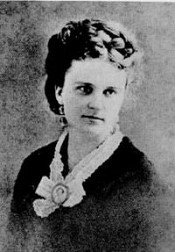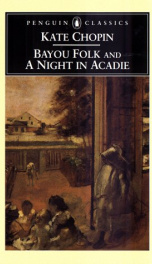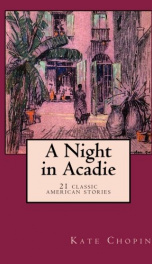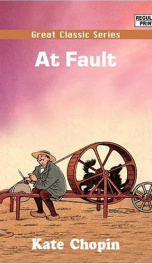Chopin Kate

Kate Chopin (born Katherine O'Flaherty on February 7, 1850 – August 22, 1904) was an American author of short stories and novels, mostly of a Louisiana Creole background. She is now considered by some to have been a forerunner of feminist authors of the 20th century. From 1869 to 1902, she wrote short stories for both children and adults which were published in such magazines as Atlantic Monthly, Vogue, the Century, and Harper's Youth's Companion. Her major works were two short story collections, Bayou Folk (1894) and A Night in Acadie (1897). Her important short stories included "Desiree's Baby," a tale of miscegenation in antebellum Louisiana (published in 1893);[1] "The Story of an Hour" (1894),[2] and "The Storm "(1898).[1] "The Storm" is a sequel to "The 'Cadian Ball," which appeared in her first collection of short stories, Bayou Folk.[1] Chopin also wrote two novels: At Fault (1890) and The Awakening (1899), which is set in New Orleans and Grand Isle, respectively. The people in her stories are usually inhabitants of Louisiana. Many of her works are set in Natchitoches in north central Louisiana. Within a decade of her death, Chopin was widely recognized as one of the leading writers of her time. In 1915, Fred Lewis Pattee[3] wrote, "some of [Chopin's] work is equal to the best that has been produced in France or even in America. [She displayed] what may be described as a native aptitude for narration amounting almost to genius." Chopin was born Kate O'Flaherty in St. Louis, Missouri. Her father, Thomas O'Flaherty, was a successful businessman who had emigrated from Galway, Ireland. Her mother, Eliza Faris, was a well-connected member of the French community in St. Louis. Her maternal grandmother, Athena'ise Charleville, was of French Canadian descent. Some of her ancestors were among the first European inhabitants of Dauphin Island, Alabama.[4] After her father's death, Chopin developed a close relationship with her mother, grandmother, and her great-grandmother. She also became an avid reader of fairy tales, poetry, and religious allegories, as well as classic and contemporary novels. Sir Walter Scott and Charles Dickens were among her favorite authors. In 1865, she returned to Sacred Heart Academy, and began keeping a commonplace book. She graduated from Sacred Heart Academy in 1868, but did not achieve any particular distinction. In 1870, at the age of 20, she married Oscar Chopin and settled in New Orleans. Chopin had all six of her children by 28. In 1879 Oscar Chopin's cotton brokerage failed, and the family moved to Cloutierville in south Natchitoches Parish to manage several small plantations and a general store. They became active in the community, and Chopin absorbed much material for her future writing, especially regarding the Creole culture of the area. Their home at 243 Highway 495 (built by Alexis Cloutier in the early part of the century) was a national historic landmark and the home of the Bayou Folk Museum. On October 1, 2008, the house was destroyed by a fire, with little left but the chimney.[5] When Oscar Chopin died in 1882 of swamp fever (like his half-brother two decades earlier), he left Kate with $12,000 in debt (approximately $229,360 in 2005 dollars). She attempted to manage the plantation and store alone but with little success. According to Emily Toth, "[f]or awhile the widow Kate ran his [Oscar's] business and flirted outrageously with local men; (she even engaged in a relationship with a married farmer. )".[6] Although Chopin made an honest effort to keep her late husband's plantation and general store alive, two years later she sold her Louisiana business. Her mother implored her to move back to St. Louis, so Chopin did, and the children gradually settled into life in St. Louis, where finances were no longer a concern. The following year, Chopin's mother died. Chopin now found herself in a state of depression after the loss of both her husband and her mother. Her obstetrician and family friend, Dr. Frederick Kolbenheyer, felt that writing would be a source of therapeutic healing for Kate during her hard times, He understood that writing could be a focus for her extraordinary energy, as well as a source of income.[7] She was quite successful and found many of her publications inside literary magazines. Some of her writings, though, such as The Awakening (1899), were far too ahead of their times and therefore not socially embraced. After almost 12 years in the public eye of the literary world and shattered by the lack of acceptance, Chopin appeared as a virtually nonexistent author. By the early 1890s, Kate Chopin was writing short stories, articles, and translations which appeared in periodicals, including the St. Louis Post-Dispatch. She became known only as a regional local color writer, but her literary qualities were overlooked. In 1899, her second novel, The Awakening, was published, and the book was criticized because of its moral, as well as its literary standards. Her best-known work, it is the story of a woman trapped in the confines of an oppressive society. Out of print for several decades, it is now widely available and critically acclaimed for its writing quality and importance as an early feminist work. Chopin, deeply discouraged by the criticism, turned to short story writing. In 1900 she wrote The Gentleman from New Orleans, and that same year she was listed in the first edition of Marquis Who's Who. However she never made much money from her writing, and depended on her investments in Louisiana and St. Louis to sustain her. While visiting the St. Louis World's Fair on August 20, 1904 Chopin suffered a brain hemorrhage and died two days later, at the age of fifty-four. She was interred in the Calvary cemetery in St. Louis. Kate Chopin experienced different lifestyles throughout her life. These lifestyles provided her with insights, understanding and allowed her an analysis of late 19th century American society. Her childhood consisted of an upbringing by women with ancestry descending from both Irish and French family. Chopin also found herself within the Cajun and Creole part of the nation after she joined her husband in Louisiana. As a result, many of her stories and sketches were about her life in Louisiana in addition to the incorporation of her less than typical portrayals of women as their own individuals with wants and needs. Chopin's seemingly unique writing style did in fact emerge from an admiration of Guy de Maupassant, who was a French short story writer. Kate Chopin went beyond Maupassant's technique and style and gave her writing a flavor of its own. She had an ability to perceive life and put it down on paper creatively. She put much concentration and emphasis on women's lives and their continual struggles to create an identity of their own within the boundaries of the patriarchy. In The Story of an Hour, Mrs. Mallard allows herself time to reflect upon learning of her husband's death. Instead of dreading the lonely years ahead of her, she stumbles upon another realization all together. "She knew that she would weep again when she saw the kind, tender hands folded in death; the face that had never looked save with love upon her, fixed and gray and dead. But she saw beyond that bitter moment a long procession of years to come that would belong to her absolutely. And she opened and spread her arms out to them in welcome"[2] Not many writers during the mid to late 19th century were bold enough to address subjects that Chopin willingly took on. Although David Chopin, her grandson, claims "Kate was neither a feminist nor a suffragist, she said so. She was nonetheless a woman who took women extremely seriously. She never doubted women's ability to be strong".[9] Despite this fact, there is no question regarding where Kate Chopin's sympathies lay: with the individual in the context of his and her personal life and society. Through her stories, Kate Chopin wrote her own autobiography and documented her surroundings; she lived in a time when her surroundings included the abolitionist movements and the emergence of feminism. Her ideas and descriptions were not true word for word, yet there was an element of nonfiction lingering throughout each story. Chopin took strong interest in her surroundings and put many of her observations to words. Jane Le Marquand saw Chopin's writings as a new feminist voice, while other intellectuals recognize it as the voice of an individual who happens to be a woman. Marquand writes, "Chopin undermines patriarchy by endowing the Other, the woman, with an individual identity and a sense of self, a sense of self to which the letters she leaves behind give voice. The 'official' version of her life, that constructed by the men around her, is challenged and overthrown by the woman of the story"[8] Chopin may have been utilizing her creative writing skills to relay a nonfiction point of view regarding her belief in the strength of women. The idea of creative nonfiction might be seen as relevant in this case. In order for a story to be autobiographical, or even biographical, Marquand goes on to write, there has to be a nonfictional element, which more often than not exaggerates the truth to spark and hold interest for the readers. There are valuable points of view outside the feminsist monopoly of criticism on women's writers but these voices do not have force in this time of political correctness. Kate Chopin may have felt just as surprised by the stamp on her work as feministic as she had been in her own time by the stamp of immorality. It is difficult in any time in history for critics to regard writers as individuals with personal points of view with no special message to a particular faction in society. Désirée's Baby focuses on Kate Chopin's experience with the Creoles of Louisiana. The idea of slavery and the atmosphere of plantation life was a reality in Louisiana. The possibility of one having a mixed background was not unheard of. Mulattos, as those with both black and white backgrounds, were a common race in the Southern part of the nation. The issue of racism that the story brings up was a reality in 19th century America. The dark reality of racism is on full, raw display in this story because Chopin was not afraid to address such issues that were often suppressed and intentionally ignored in order to avoid reality, as Armand does when he refuses to believe that he is of black descent. The definition of great fiction is that which has the only true subject of "human existence in its subtle, complex, true meaning, stripped of the view with which ethical and conventional standards have draped it".[10]
do you like this author?
What readers are saying
What do you think? Write your own comment on this book!
write a commentWhat readers are saying
What do you think? Write your own comment on this author!
write a commentBook list

bayou folk
Series:
Unknown
Year:
Unknown
Raiting:
3.5/5
Short fiction by Kate Chopin, a nineteenth century American author of short stories and novels. This work being a prelude to Chopin's great novel, “The Awakening” (1899) reflects the duality of the author’s position: she is bent on glorifying a woman’s thirst for independence from the one hand, and understands intuitively the losses the “birth” of a new type of person involves, from the other hand. She was one of the first who touched upon the question of woman’s sensitivity as a part of female identity.
Show more
add to favoritesadd In favorites

a night in acadie
Series:
Unknown
Year:
Unknown
Raiting:
1/5
Kate Chopin (born Catherine O'Flaherty, 1850-1904) was an American author of short stories and novels, mostly of a Louisiana Creole background. She is now considered by some to have been a forerunner of feminist authors of the 20th century. From 1869 to 1902, she wrote short stories for both children and adults which were published in such magazines as "Atlantic Monthly," "Vogue," the "Century," and "Harper's Youth's Companion." Her major works were two short story collections, "Bayou Folk" (1894) and "A Night in Acadie" (1897). This volume includes 21 of Chopin's classic short works. Here are: A Night in Acadie Athénaïse After the Winter Polydore Regret A Matter of Prejudice Caline A Dresden Lady in Dixie Nég Créol The Lilies Azélie Mamouche A Sentimental Soul Dead Men's Shoes At Chênière Caminada Odalie Misses Mass Cavanelle Tante Cat'rinette A Respectable Woman Ripe Figs Ozéme's Holiday
Show more
add to favoritesadd In favorites
Book list

bayou folk
Series:
Unknown
Year:
Unknown
Raiting:
3.5/5
Short fiction by Kate Chopin, a nineteenth century American author of short stories and novels. This work being a prelude to Chopin's great novel, “The Awakening” (1899) reflects the duality of the author’s position: she is bent on glorifying a woman’s thirst for independence from the one hand, and understands intuitively the losses the “birth” of a new type of person involves, from the other hand. She was one of the first who touched upon the question of woman’s sensitivity as a part of female identity.
Show more
add to favoritesadd In favorites

a night in acadie
Series:
Unknown
Year:
Unknown
Raiting:
1/5
Kate Chopin (born Catherine O'Flaherty, 1850-1904) was an American author of short stories and novels, mostly of a Louisiana Creole background. She is now considered by some to have been a forerunner of feminist authors of the 20th century. From 1869 to 1902, she wrote short stories for both children and adults which were published in such magazines as "Atlantic Monthly," "Vogue," the "Century," and "Harper's Youth's Companion." Her major works were two short story collections, "Bayou Folk" (1894) and "A Night in Acadie" (1897). This volume includes 21 of Chopin's classic short works. Here are: A Night in Acadie Athénaïse After the Winter Polydore Regret A Matter of Prejudice Caline A Dresden Lady in Dixie Nég Créol The Lilies Azélie Mamouche A Sentimental Soul Dead Men's Shoes At Chênière Caminada Odalie Misses Mass Cavanelle Tante Cat'rinette A Respectable Woman Ripe Figs Ozéme's Holiday
Show more
add to favoritesadd In favorites

At Fault
Series:
Unknown
Year:
Unknown
Raiting:
3.5/5
An early work of Kate Chopin, an American author of short stories and novels. “At Fault” focuses on the complicated and sensitive problem of divorce. It tells a story of a widowed woman who refuses the proposal of a divorced businessman due to her strong moral and religious convictions. The book provides valuable insight into Kate Chopin’s thematic and literary development.
Show more
add to favoritesadd In favorites
What readers are saying
What do you think? Write your own comment on this author!
write a commentif you like Chopin Kate try:

Maggie Stiefvater
(Author)

Kristin Cashore
(Author)

Jeaniene Frost
(Author)

Jerry Spinelli
(Author)

Lisa Mantchev
(Author)

Lauren Henderson
(Author)

Lisa Jane Smith
(Author)

Becca Fitzpatrick
(Author)

Meg Cabot
(Author)

Lauren Kate
(Author)

Hailey Abbott
(Author)

Andrea R Cremer
(Author)

Sara Zarr
(Author)

michelle Rowen
(Author)

Kelley Armstrong
(Author)

Sophie Kinsella
(Author)

Marion Zimmer Bradley
(Author)

Amelia Atwater-Rhodes
(Author)

Amy Huntley
(Author)

Veronica Roth
(Author)

Michelle Zink
(Author)
readers also enjoyed
What readers are saying
What do you think? Write your own comment on this author!
write a commentif you like Chopin Kate try:
readers also enjoyed
Do you want to exchange books? It’s EASY!
Get registered and find other users who want to give their favourite books to good hands!



